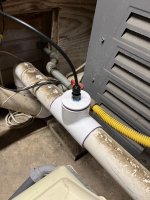Hi all,
I just got my Stenner pump and now need to install the injector. I could use some guidance
Based of what I've read, I see three options:
So I'm probably going with #3 and if I screw up, fall back to #1. But I have some questions:
Thanks all!
I just got my Stenner pump and now need to install the injector. I could use some guidance
Based of what I've read, I see three options:
- using a 2" x 2" x 1/4" tee such as this one: 2" x 2" x 1-1/4" Sch 40 PVC Reducing Tee Soc 401-250 . This seems to be the most reliable way to provide a leak-free injection point. But it's also the most intrusive, and I'm terrified at the idea of cutting my pipe.
- using a saddle clamp, like this one: Pentair 2 . This is the least invasive method (you just need to drill a hole), but gosh that piece of plastic is expensive.
- using an NPT pipe tap to create threads. This seems to be a good compromise between intrusiveness and ease of execution.
So I'm probably going with #3 and if I screw up, fall back to #1. But I have some questions:
- would this be the correct tap to use? Drill America 1/4 in. -18 Carbon Steel NPT Pipe Tap DWTPT1/4 - The Home Depot . I'm kinda lost between all the standards (NPT, NPTF, ...)
- if yes, as NPT threads diameter increases the deeper you go, how deep should I tap into my 2" schedule 40 pipe?
- finally, when it's time to screw in the injector, will I need to use additional sealant material (tape)?
Thanks all!



